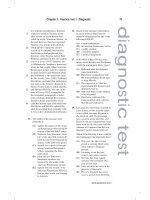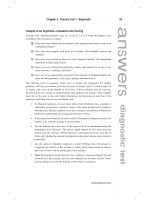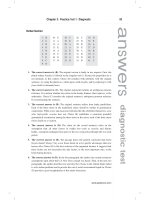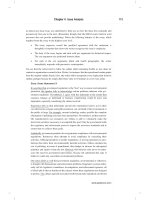Master gmat 2010 part 7 doc
Bạn đang xem bản rút gọn của tài liệu. Xem và tải ngay bản đầy đủ của tài liệu tại đây (43.7 KB, 10 trang )
KEY FACTS ABOUT GMAT CRITICAL REASONING
Keep in mind the following important features of Critical Reasoning questions:
• Your knowledge of the topic at hand is not important in answering Critical
Reasoning questions. The test makers design Critical Reasoning questions so
that you can analyze and answer them without regard to what is factual (or not) in
the real world. Also, whatever your personal opinions or viewpoints about the issue
that an argument raises, they are irrelevant to analyzing the argument and
answering the question.
• Distinctions in quality between answer choices can be subtle. GMAT Critical
Reasoning is not a “black-and-white” affair in which one answer is perfect while
each of the others is completely wrong. A typical Critical Reasoning question stem
contains a word such as “best” or “most.” That’s because more than one answer
choice usually has merit—it’s just that the correct answer choice is the strongest
among the bunch. (To master GMAT Critical Reasoning, you’ll need to become
comfortable with these shades of gray.)
• Each piece of information in the paragraph is usually important in
answering the question. Occasionally, a Critical Reasoning paragraph will
include superfluous information, which does not come into play at all in analyzing
the argument and answering the question. But this is the exceptional case.
Sentence Correction (14–15 questions)
Sentence Correction questions are designed to measure your command of the English
language and of the conventions of Standard Written English. GMAT Sentence Correction
covers two areas of English language proficiency:
Correct expression, measured by your ability to recognize errors in grammar,
diction, and word usage
Effective expression, measured by your ability to improve sentences that are poorly
worded or structured
GMAT Sentence Correction does NOT cover three other areas of English language proficiency:
Punctuation (except that comma placement can come into play if it affects the
meaning of a sentence)
Vocabulary (you won’t have to memorize long lists of obscure words just for GMAT
Sentence Correction)
Slang and colloquialisms (informal expressions don’t appear at all in Sentence
Correction questions)
Chapter 2: GMAT Questions: A First Look 43
www.petersons.com
TEST DIRECTIONS
The following directions are essentially what you’ll see during the pre-test tutorial and just
prior to your first Sentence Correction question (you can access these directions at any time
by clicking on the HELP button):
Directions: This question presents a sentence, all or part of which is underlined.
Beneath the sentence you will find five ways of phrasing the underlined part. The first
of these repeats the original; the other four are different. If you think the original is
best, choose the first answer; otherwise, choose one of the other answers.
This question tests correctness and effectiveness of expression. In choosing your answer,
follow the requirements of Standard Written English; that is, pay attention to grammar,
choice of words, and sentence construction. Choose the answer that produces the most
effective sentence; this answer should be clear and exact, without awkwardness,
ambiguity, redundancy, or grammatical error.
WHAT SENTENCE CORRECTION QUESTIONS LOOK LIKE
In each Sentence Correction question, part of a sentence (or the whole sentence) will be
underlined. The first answer choice will simply restate the underlined part “as is.” The other
four choices present alternatives to the original underlined phrase.
Let’s look at two questions that are similar to what you might see on the GMAT. (Answer
choices are lettered A–E here. Remember, though, that on the actual GMAT you’ll select
among choices by clicking on one of five blank ovals, not letters.) This first question is a bit
easier than average; among GMAT test takers, about 80 percent would answer this question
correctly.
A thesaurus can be a useful tool for writers, providing he knows how to use it
correctly.
(A) writers, providing he knows how to use it
(B) writers, providing he knows how to use such a book
(C) a writer, providing he knows how to use them
(D) writers, providing she knows how to use it
(E) writers, providing they know how to use it
44 PART I: GMAT Basics
www.petersons.com
The correct answer is (E). A pronoun and the noun to which it refers (called
the antecedent) should be consistent; both should be either singular or plural.
In the original sentence, however, the singular pronoun he is inconsistent with
its plural antecedent writers. Among the four alternatives, only choices (C) and
(E) fix this problem. In choice (C), both are singular, while in choice (E) both
are plural; either is acceptable. Choice (C), however, creates another pronoun-
antecedent error. Notice that it replaces the singular pronoun it with the plural
them. Since the intended antecedent is thesaurus, which is singular, the plural
pronoun them is incorrect, and you can eliminate choice (C). Choice (E) is the
best version of the underlined part; it fixes the problem with the original
version without creating any new errors.
Here’s a Sentence Correction question that’s a bit more difficult than average. Of all GMAT
test takers, only about 55 percent would respond correctly to it.
Frank Lloyd Wright was a preeminent architect of the twentieth century, and
there have been many less talented people who, both in the past and today,
have imitated his style.
(A) there have been many less talented people who, both in the past and
today, have
(B) a great number of less talented people of today, as well as in the
past, have
(C) many less talented people, both in the past and today, have
(D) there are many less talented people, today as well as in the past, who
(E) many people less talented than Wright who, today as well as in the
past, have
The correct answer is (C). The original version contains no grammatical
errors. However, the phrase there have been many less talented people who is
wordy. Choice (C) provides a more concise and graceful version, without
introducing any new errors. In choice (B), a great number of is wordy; also, the
two phrases of today and in the past lack grammatical parallelism. Choice (D)
provides a less wordy version than the original, but is still not as effective as
choice (C). As for choice (E), it too is unnecessarily wordy; what’s more, within the
construction of choice (E), the word who creates an incomplete sentence and
should be omitted.
KEY FACTS ABOUT GMAT SENTENCE CORRECTION
Keep in mind the following important features of Sentence Correction questions (some of
these points are review):
• Any part of the sentence might be underlined. The underlined part may
appear at the beginning, middle, or end of the sentence. Also, in some cases, the
entire sentence will be underlined. Expect all of these variations on your exam.
Chapter 2: GMAT Questions: A First Look 45
www.petersons.com
• The first answer choice simply repeats the underlined part. The other four
choices present alternatives to the original underlined phrase.
• The best answer choice isn’t always perfect. The best choice among the five will
not contain any grammatical errors. However, it may make for a less-than-ideal
sentence, at least in your opinion. But remember: You’re looking for the best version
of the five, not the perfect version.
• More than one answer choice may be grammatically correct. These questions
cover not just grammar but also effective expression. So don’t select an answer
choice just because it results in a grammatically correct sentence. Another answer
choice may be clearer, more concise, or less awkward—and therefore better.
• A single Sentence Correction item can cover a lot of ground. Don’t expect
each Sentence Correction item to isolate and test you on one, and only one, rule of
grammar or aspect of written expression. Typically, by the time you’ve read all five
choices, you’ve seen a variety of grammatical errors and other problems—at least
among the four incorrect choices.
• Punctuation doesn’t matter. You won’t find errors in punctuation in these
sentences (except as part of larger errors involving sentence structure).
• You won’t need any knowledge of the topic at hand in order to handle a
question. You’re at no disadvantage if you know little or nothing about the topic of
any particular sentence. For instance, in handling the second question above,
experts on Frank Lloyd Wright would not have any advantage over other test
takers, would they?
Reading Comprehension (12–13 questions)
GMAT Reading Comprehension questions are designed to measure your ability to read
carefully and accurately, to determine the relationships among the various parts of the
passage, and to draw reasonable inferences from the material in the passage. On the GMAT,
you’ll encounter four sets of Reading Comprehension questions; all questions in a set pertain
to the same passage and are presented in sequence. GMAT Reading Comprehension tests the
following reading skills (you can think of these skills as question types):
• Recognizing the main point or primary purpose of the passage
• Recalling information explicitly stated in the passage
• Making inferences from specific information stated in the passage
• Recognizing the purpose of specific passage information
• Applying and extrapolating from the ideas presented in the passage
46 PART I: GMAT Basics
www.petersons.com
TEST DIRECTIONS
The following directions are essentially what you’ll see during the pre-test tutorial and just
prior to your first group of Reading Comprehension questions (you can access these directions
at any time by clicking on the HELP button):
Directions: The questions in this group are based on the content of a passage. After
reading the passage, choose the best answer to each question. Answer all questions on
the basis of what is stated or implied in the passage.
WHAT READING COMPREHENSION SETS LOOK LIKE
Each Reading Comprehension set consists of a reading passage along with a series of 3–4
questions about the passage. Here’s a typical passage. Go ahead and read it now.
Line Urodeles, a class of vertebrates that includes small, lizard-like creatures such as
newts and salamanders, have an enviable ability to regenerate arms, legs, tails, heart
muscle, jaws, spinal cords, and other organs that are injured or destroyed by accidents
or those who prey on them. Planaria, which are a type of simple worm, have their own
form of regenerative power. A single worm can be sliced and diced into hundreds of
pieces, each piece giving rise to a completely new animal. However, while both urode-
les and planaria have the capacity to regenerate, they use different means to accom-
plish this feat.
In effect, urodeles turn back the biological clock. First, the animal heals the wound
at the site of the missing limb. Then, various specialized cells at the site, such as
bone, skin, and blood cells, lose their identity and revert to cells as unspecialized as
those in the embryonic limb bud. This process is called dedifferentiation, and the
resulting blastema, a mass of unspecialized cells, proliferates rapidly to form a limb
bud. Ultimately, when the new limb takes shape, the cells take on the specialized roles
they had previously cast off.
In contrast, planaria regenerate using cells called neoblasts. Scattered within the
planarian body, these neoblasts remain in an unspecialized, stem-cell state, which
enables them at need to differentiate into any cell type. Whenever planaria are cut,
the neoblasts migrate to the site and form a blastema by themselves. It is interesting
to note that this mechanism is similar to that following reproductive fission in these
animals, and that species incapable of this form of asexual reproduction have poorly
developed regenerative capacities.
Now, look at two questions based on the preceding passage. (Answer choices are lettered A–E
here. Remember, though, that on the actual GMAT you’ll select among choices by clicking on
one of five blank ovals, not letters.) This first question is a bit easier than average; among
GMAT test takers, about 80 percent would answer this question correctly.
Chapter 2: GMAT Questions: A First Look 47
5
10
15
20
www.petersons.com
The author’s primary purpose in the passage is to
(A) describe the roles of blastema in regenerating urodeles and planaria.
(B) describe how urodeles use the process of dedifferentiation to regenerate.
(C) contrast the mechanisms by which urodeles and planaria accomplish
regeneration.
(D) show how methods of cellular regeneration have evolved in different
animal species.
(E) explain the link between reproductive fission and regeneration in simple
worms.
The correct answer is (C). The last sentence of the first paragraph sets forth
this central theme: that urodeles and planaria differ in the means they use to
regenerate. The paragraphs that follow provide the details that reveal those
differences. The second paragraph discusses how urodeles regenerate, while the
third paragraph discusses how planaria regenerate. (Notice the phrase “In
contrast,” which begins the third paragraph.) Each of the incorrect choices
distorts the author’s central focus in the passage.
Here’s a question that’s a bit more difficult than average. Of all GMAT test takers, only about
50 percent would respond correctly to it.
In the final sentence of the passage (lines 19–22), the author implies that
(A) reproductive fission and regeneration in certain planaria differ solely in
the quantity of new planaria produced.
(B) planaria that reproduce sexually use the process of dedifferentiation to
regenerate entirely new animals.
(C) asexual reproduction is related to regeneration in planaria but not in
urodeles.
(D) the genetic makeup of planaria created through regeneration would be the
same as in those created through reproductive fission.
(E) those planaria that reproduce by splitting themselves in two are more
likely to regenerate using the same mechanism.
The correct answer is (E). The idea in the final sentence of this passage is
difficult to grasp, making this question difficult to answer. The sentence says
essentially that those species of planaria that do not engage in reproductive
fission (i.e., splitting) are less likely to regenerate themselves in this way. Choice
(E) expresses the same essential idea conversely: species of planaria that
reproduce asexually (by fission or splitting) are the ones that are more likely to be
able to regenerate in the same way.
48 PART I: GMAT Basics
www.petersons.com
KEY FACTS ABOUT GMAT READING COMPREHENSION
Keep in mind the following important features of GMAT Reading Comprehension (some of
these points are review):
• Passages appear on the left side of the computer screen, and questions
appear (one at a time) on the right side. You’ll have to scroll vertically to read
each entire passage, even the short ones.
• Reading Comprehension questions are designed to test a lot more than just
your short-term memory and your knack for finding information quickly.
Although your ability to recall what you’ve read is part of what’s being tested, all
but the easiest questions also gauge your ability to assimilate, interpret, and apply
the ideas presented.
• Some questions require that you focus on an isolated sentence or two;
others require that you assimilate information from various parts of
the passage. Understandably, questions that cover disparate parts of a passage
tend to be tougher than ones that you can answer just by reading a particular
sentence or two.
• Questions about information appearing early in the passage tend to come
before other questions. However, this isn’t a hard-and-fast rule; don’t assume you
can simply scroll down the passage to answer each question in turn.
• Tougher questions include not only a “best” response but also a tempting
second-best response. Recognizing the difference in quality between the two most
viable responses is the key to answering the questions correctly.
• Reading Comprehension questions are not designed to test your vocabu-
lary. Sure, you’ll find the occasional advanced, technical, or obscure word. But the
test makers don’t intentionally load the passages with tough vocabulary. Also, if a
reading passage introduces a technical term, don’t worry—the passage will supply
all you need to know about the term to respond to the questions.
• Reading Comprehension passages are condensed from larger works in the
humanities, social sciences, and physical sciences. Specific sources include
professional journals, dissertations, and periodicals of intellectual interest. The test
makers edit the source material in order to pack it with test-worthy material.
• All reading passages are not created equal—that is, equally difficult. Com-
paratively tough passages are typically written in a dryer, more “academic” style than
easier ones. Syntax is more complex and vocabulary more advanced. The passage’s
topic might deal with ideas and concepts that are more difficult to grasp, or it might be
written, organized, or edited in a way that makes it more difficult to assimilate.
• Prior knowledge of a passage’s subject matter is not important. All questions
are answerable based solely on information in the passage. The exam includes
passages from a variety of disciplines, so it is unlikely that any particular test taker
knows enough about two or more of the areas included on the test to hold a
significant advantage over other test takers.
Chapter 2: GMAT Questions: A First Look 49
www.petersons.com
SUMMING IT UP
• Each Analytical Writing Assessment essay requires you to compose an essay using the
GMAT’s built-in word processor. You have 30 minutes for each essay; your topic is drawn
randomly from a large pool.
• You’ll be graded on the AWA essays for content, organization, writing style, and
mechanics.
• For the Issue Analysis essay, you compose an essay based on a topic that consists of a
statement of opinion.
• For the Argument Analysis essay, you compose an essay in which you critique a
paragraph-length argument based on the strength of the evidence presented in support of
it and on the argument’s logic.
• Problem Solving and Data Sufficiency questions in the Quantitative section of the GMAT
measure your proficiency in arithmetical operations and solving algebraic equations, your
ability to convert verbal information into mathematical terms, to visualize geometric
shapes and numerical relationships, and to devise solutions to mathematical problems.
• The Verbal Section of the GMAT consists of three parts: Critical Reasoning, Sentence
Correction, and Reading Comprehension.
• Critical Reasoning measures your ability to understand, criticize, and draw reasonable
conclusions from arguments.
• Sentence Correction measures your command of the English language and the
conventions of Standard Written English.
• Reading Comprehension tests your ability to read carefully and accurately, determine the
relationships among the various parts of the passage, and draw reasonable inferences
from the material in the passage.
50 PART I: GMAT Basics
www.petersons.com
P
ART II
DIAGNOSING STRENGTHS
AND WEAKNESSES
CHAPTER 3 Practice Test 1: Diagnostic









